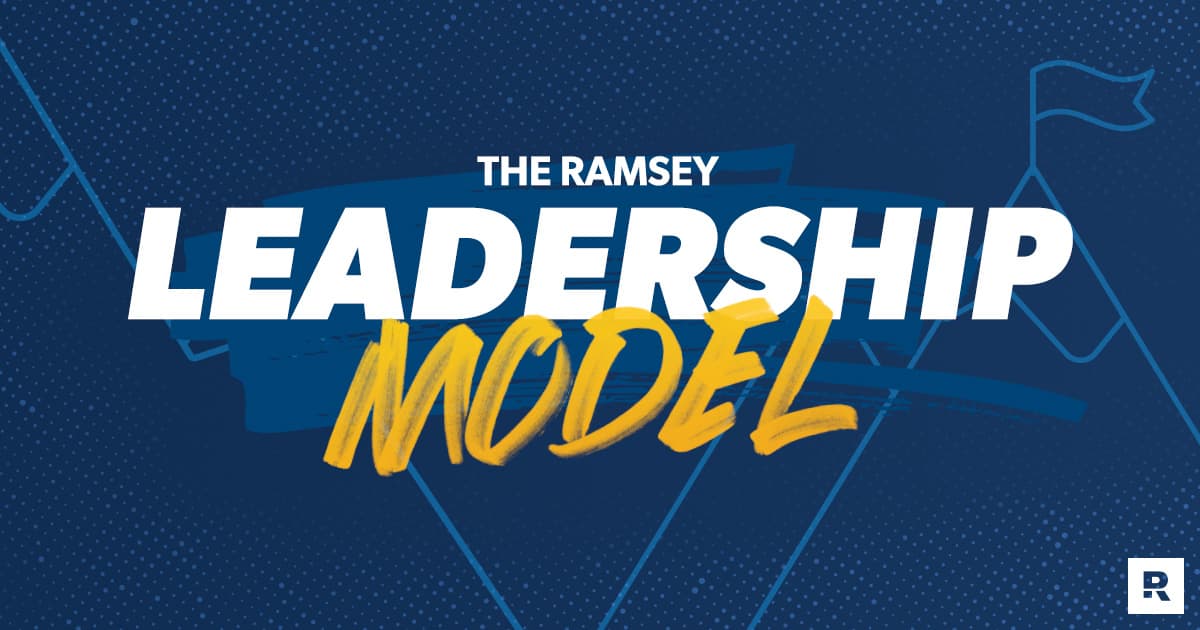
If you’ve ever wondered if only certain personalities have what it takes to be a great leader, wonder no more. Successful leaders come in all kinds of packages—from hard-charging and charismatic to low-key and calculated. But there are a couple of things all great leaders do: Make the choice to lead and then work like crazy to grow and build influence.
If we had to guess, that’s why you’re here. You’ve made the choice to lead in your organization and want a leadership model that will help you do it well. That’s awesome! Who wouldn’t want a guide that keeps you focused on the right things for personal growth?
The system we use every day at Ramsey Solutions to develop leaders is called the Ramsey Leadership Model. And it can help transform you and your leadership team too. In just a minute we’ll walk through the model’s three disciplines—vision, relationships and results—but first let’s tackle what a leadership model is and why leadership is so important.
What Is a Leadership Model?
When we talk about a leadership model, you might think we’re referring to a people-management theory that sounds fancy on paper but doesn’t make you a better leader in real life. Don’t worry, we’re not. An effective leadership model—like the Ramsey Leadership Model—shows you what’s most important to focus on so you and your team experience personal transformation that ultimately helps you build influence and grow your business.
Why Is Great Leadership Important?
A word of caution: Don’t get stuck on the “grow your business” part like some people do. That’s when you risk using your leadership position as a means to a selfish end. He (or she) with the biggest empire wins, right? Wrong. He who can’t think past his own empire misses the gift of building a world-changing legacy! That’s not something you want to do.
As you succeed as a leader, you’ll change lives and whole family trees both now and long after your years on earth. That’s why you’ll often hear us say at Ramsey that truly great leaders don’t just build a business—they build the people who build the business.
Related article: What Is Leadership?
The Ramsey Leadership Model
So what are the details of this Ramsey Leadership Model we speak of? You’re about to find out! And as you apply it, you’ll start to develop a team that’s inspired with better ideas, knows they matter and their work matters, and feels safe playing to win (instead of playing not to lose).
The critical factor, though, is applying the model. As Bobby Knight, one of the winningest college basketball coaches of all time, put it, “The key is not the will to win . . . everybody has that. It is the will to prepare to win that is important.”
Applying these disciplines will prepare you to win.

Leadership Model Discipline #1: Vision
Great leaders see the future and move their team toward achieving their goals.
Vision is seeing a future you believe can happen and having the conviction that, come hell or high water, it must happen. A great vision moves people to action because it rings true in their hearts and minds. But here’s the thing: You can’t keep your vision in your head and expect your team to get it. You have to cast it.
That’s what President John F. Kennedy did in 1961 when he boldly told Congress, “I believe that this nation should commit itself to achieving the goal, before this decade is out, of landing a man on the moon and returning him safely to the Earth.” His vision boiled down to two ideas:
- We’re going to the moon.
- It will be difficult and pricy but is important and impressive.
Did Kennedy have a 12-point plan for reaching that goal? No. Landing someone on the moon was a mind-boggling challenge! But Kennedy’s clear direction set in motion the U.S. lunar exploration program. Just eight years later, astronaut Neil Armstrong became the first human to set foot on the moon.
How Do You Cast Your Vision?
The vision you have for your organization probably doesn’t include a space expedition. But it could be to launch an out-of-this-world pizza restaurant. Whatever the future you see looks like, make sure it’s true to your company’s strategy, values and mission. Then share it with your team members until they can repeat it in their sleep and are moving toward it with you.
You probably thought running a business sounded fun—until you realized it would actually run you. Discover the EntreLeadership System—the small-business road map that takes the guesswork out of growth.
Here’s how you do that:
- Make the complex simple. Is your vision specific, measurable and memorable?
- Make the vision actionable. Is it compelling? Does it include clear objectives that show your team where to go?
- Go first and keep beating the drum. What’s the life change your vision creates at scale? Explain to your team why your vision matters—and keep explaining it. Also, share the profit impact of your vision. Does it drive revenue, save money, increase efficiency, improve operations, or all of the above? Giving your team that insight makes it easier for them to pursue your vision alongside you.
Casting vision isn’t always about a fun or celebrated future. Sometimes you need to rally your team to do important but really hard stuff. When that happens, the formula stays the same. Keep the vision simple, make it actionable, and go first while beating the drum.
Related articles:
Vision Casting
Best Small-Business Quotes
Free EntreLeadership Reading Guide
What should EntreLeaders read? We've got our list of book recommendations, with 100 book titles on topics like hiring, business strategy, sales, leadership and more!
Leadership Model Discipline #2: Relationships
Great leaders create deep, vulnerable, authentic relationships with the people they lead.
Even when your vision is clear and compelling, it doesn’t matter until people care and buy in to it. And they’re not going to care about it unless they know you care about them.
Here’s the deal: Your team members are human beings with families, friends, hopes and dreams—not units of production. If you only see a team member as someone you can get something out of, you’re going to burn people and a whole lot of bridges. Treat others how you want to be treated.
Pro tip: Ask yourself if people naturally ask, “What do you want?” when they see you coming. That could be a sign you’re not building relationships—you’re just trying to get what you need.
How Do You Lead Relationally?
Armando Lopez, senior executive director of human resources at Ramsey Solutions, developed the Partnership Model to describe how relationships grow. “When you get to know your people as people, not as cogs in a machine, you gain incredible influence and loyalty,” he says.
Here’s how it works. Each phase of the Partnership Model builds on the next one. No skipping steps! It takes time and patience to build connection and grow as a relational leader. Here’s what to focus on in each phase:
- Rapport
Rapport simply means connection and understanding. You build it by learning about your team members—what they value most, how they like to spend their free time, who’s most important in their lives. Knowing and using their DISC profiles can help you communicate in a way that’s comfortable for them. - Credibility
This means doing what you say you’ll do. You earn credibility by being honest, reliable and showing expertise in what you do. Every time you meet a deadline, turn in excellent work, or show up when you say you will, your team sees you as credible. - Trust
Trust is earned when your team members know you’re a safe person. They have faith you’ve got their backs and would support them if their names ever came up in a meeting or conversation—even if you don’t have context and details from them yet. - Influence
You know you’ve got influence when people want you to give your advice and opinion about work and even situations beyond work. They care what you think. But remember: You only become an influencer by working through the other steps first. - Partnership
Voila! You become true partners. Not just any partners though, partners who give each other the benefit of the doubt through any conflict.
Leadership Model Discipline #3: Results
Great leaders build winning businesses that are growing and healthy.
You may have heard people say that nothing happens until someone sells something. What that means is, without results, you don’t have a business. How do you get good results? It boils down to three major things:
- Ruthless Prioritization
You don’t want to be stretched a mile wide but only an inch deep. So get laser-focused on your goals. - Excellence in Ordinary Operations
It takes discipline to bring your A-game consistently and look for ways to improve daily operations. How consistent are you with things like coming to meetings prepared or following up with team members on their weekly reports? - Accountability
Accountability means being responsible for your actions and getting things done the right way. As the leader, you’re responsible for yourself and for helping your team members get their stuff done. That’s easy when they excel. You can shout them out and show appreciation! But what about when they’re struggling or in need of correction? You never want to shame a team member, but you do need to talk with them directly and help them get back on track. To be unclear is to be unkind.
Remember Your End Game—Real, Personal Transformation
Great leaders function as whole people with strong integrity and character in every facet of life.
Casting vision, building relationships, and getting results won’t get you far unless they’re tied to real transformation. That’s when you earn trust—and lasting influence. Here’s how to get there:
- Own your personal growth and development. Leaders are built, not born. That means you can get better.
- Be known for your strong character in every facet of your life. At Ramsey, we expect our leaders to consistently represent Christ and our company as godly, world-class leaders.
- Don’t look at this leadership model as a report card showing success and failure. Use it to guide where you want to transform next. These two questions will help you stay focused:
- Which area do you need to grow in the most?
- What’s one step you can take to get better?
You’ve got this—one step at a time!
Next Step: Read to Lead
To help you own your development and stay inspired, we’ve put together a list of 100 books every small-business owner and leader needs to read.
Get the EntreLeadership Reading Guide.

